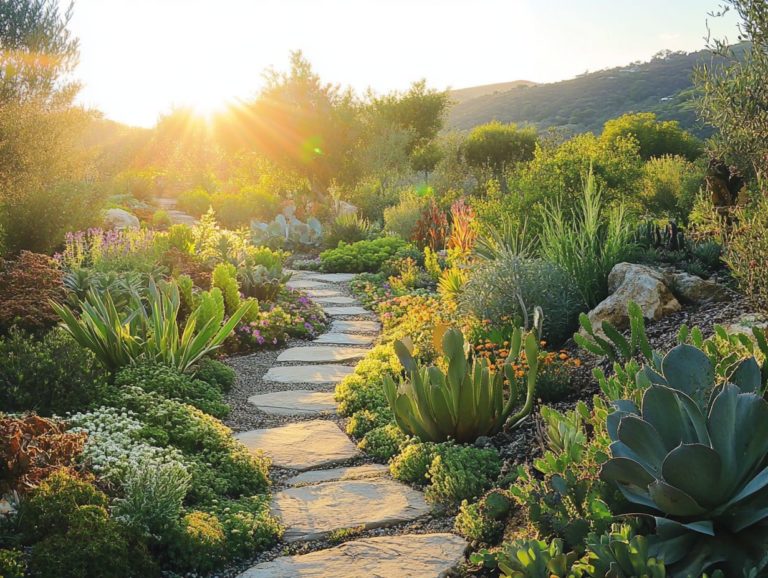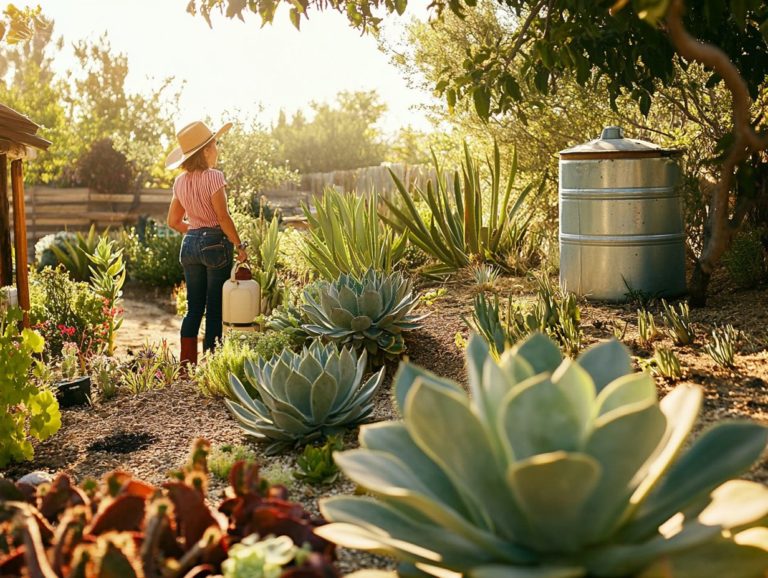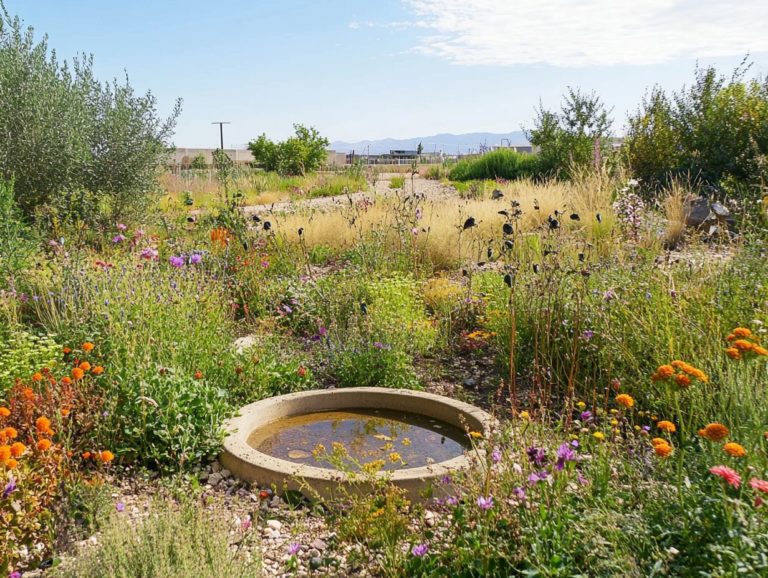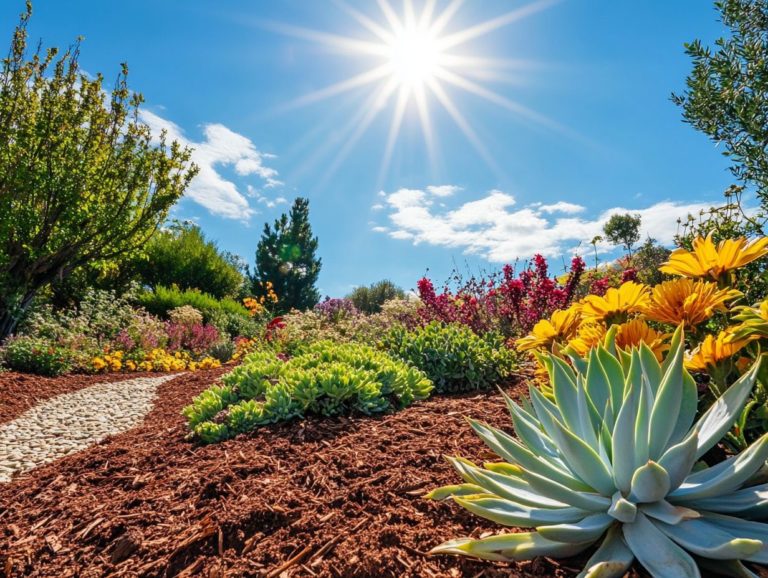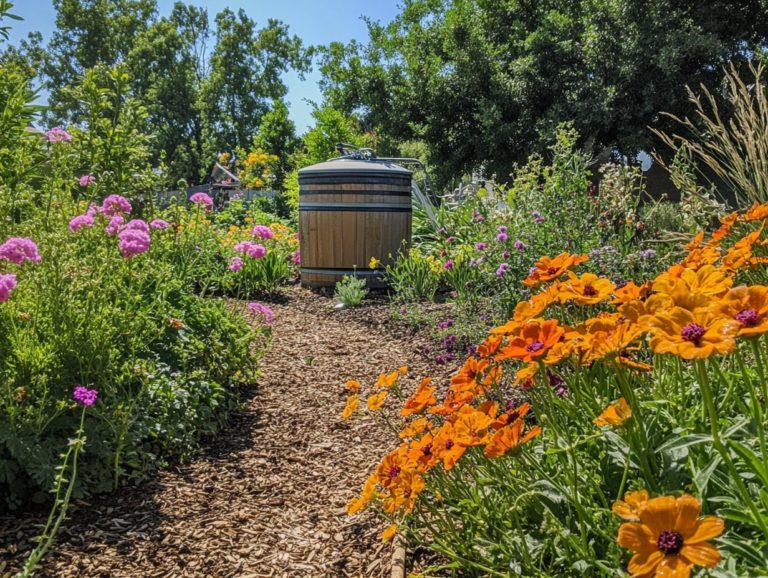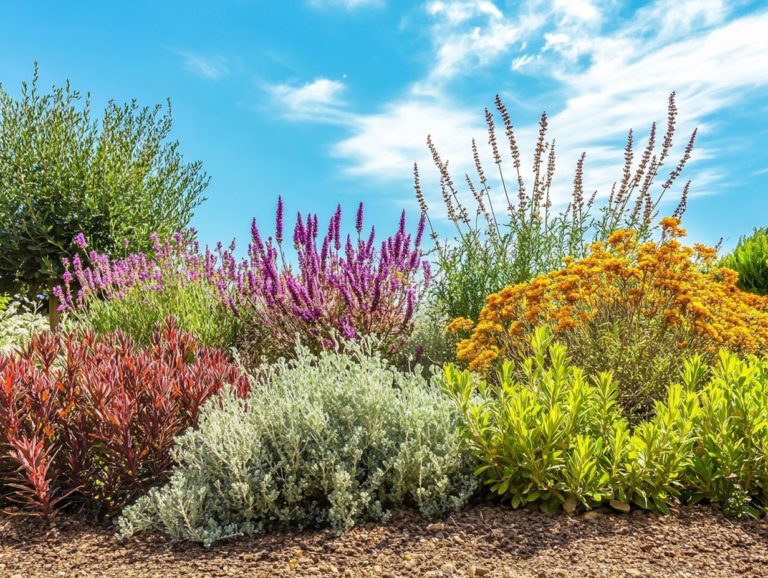The Cost Savings of Drought-Resistant Gardening
Are you ready to transform your garden into a stunning, drought-resistant oasis? Start conserving water and saving money today! Drought-resistant gardening transcends mere sustainability; it s a savvy way to nurture a vibrant garden while conserving water and keeping costs in check.
This article delves into the myriad environmental and financial advantages of selecting drought-resistant plants. You ll uncover their distinctive characteristics and explore innovative garden design techniques that enhance your outdoor space.
With essential maintenance tips at your disposal, your garden will flourish with minimal water. Experience how this gardening style not only beautifies your surroundings but also contributes to substantial cost savings.
Embark on your journey to create a flourishing drought-resistant garden today!
Contents
- Key Takeaways:
- Benefits of Drought-Resistant Gardening
- Choosing Drought-Resistant Plants
- Creating a Drought-Resistant Garden
- Maintaining a Drought-Resistant Garden
- Cost Savings of Drought-Resistant Gardening
- Frequently Asked Questions
- What is drought-resistant gardening and how can it save me money?
- What are the key benefits of implementing drought-resistant gardening?
- What are some examples of drought-resistant plants?
- Do I need to completely overhaul my current garden to make it drought-resistant?
- Are there any financial incentives for implementing drought-resistant gardening?
- Can I still have a beautiful garden with drought-resistant gardening?
Key Takeaways:
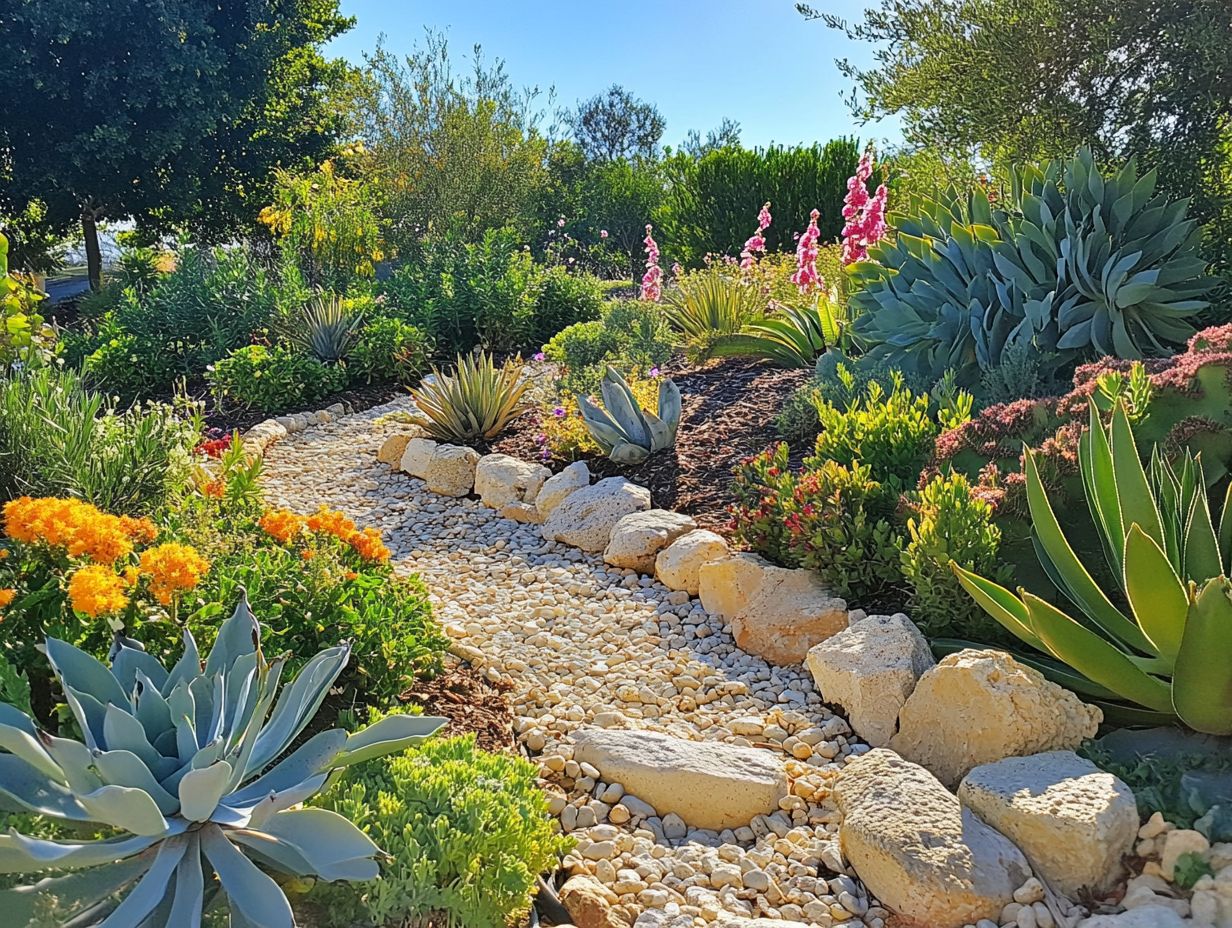
- Drought-resistant gardening saves you money while protecting the environment by cutting down on water use.
- Choose drought-tolerant plants to lower your water bills and maintenance costs.
- Adopt these practices for long-term savings and a resilient garden!
What is Drought-Resistant Gardening?
Drought-resistant gardening offers a sophisticated approach to landscape design, emphasizing the use of native plants (species that naturally grow in the local area) and drought-tolerant species, especially in regions like California, where water conservation is paramount.
This gardening philosophy is rooted in the principles of leveraging local flora and xeriscaping (a landscaping method that reduces the need for irrigation), which employs design techniques that minimize water usage while enhancing visual appeal.
By incorporating California native plants that have adapted seamlessly to the region’s climate and soil, you can cultivate resilient landscapes that not only withstand but flourish in arid conditions.
These gardens often feature mulch and thoughtfully placed hardscaping elements to reduce evaporation and curb weed growth, merging functionality with beauty. The ecological advantages are significant, including improved soil health and reduced runoff, making drought-resistant gardening an intelligent choice for both homeowners and the environment.
Benefits of Drought-Resistant Gardening
Drought-resistant gardening presents a wealth of benefits that encompass both environmental and financial advantages, making it a compelling choice for homeowners and commercial properties alike. For those interested in maximizing these advantages, exploring the long-term benefits of drought gardening can help you minimize reliance on traditional irrigation systems, promoting water conservation and sustainability.
By selecting drought-tolerant species and native plants, you can significantly reduce maintenance costs, as these resilient plants generally require far less care than their thirsty counterparts.
Employing water-saving strategies like mulching, smart irrigation, and retention basins boosts the health of your garden and helps preserve valuable resources.
Environmental and Financial Benefits
The environmental and financial benefits of drought-resistant gardening are extensive, presenting a persuasive argument for its adoption in both residential and commercial landscaping.
When you choose native plant species, you’re not just conserving water; you re also creating habitats that boost local biodiversity and enrich the ecosystem.
By implementing rain gardens or xeriscaping, your community can experience a marked decrease in irrigation costs while also enjoying reduced runoff, which plays a crucial role in minimizing water pollution.
As these gardens mature, you ll find that the need for fertilizers and pesticides declines, resulting in lower maintenance expenses. Ultimately, these practices champion environmental stewardship while ensuring you reap financial savings, making sustainable landscaping a true win-win for both nature and your budget.
Join the movement towards a sustainable future. Start your drought-resistant garden today and watch it thrive!
Choosing Drought-Resistant Plants
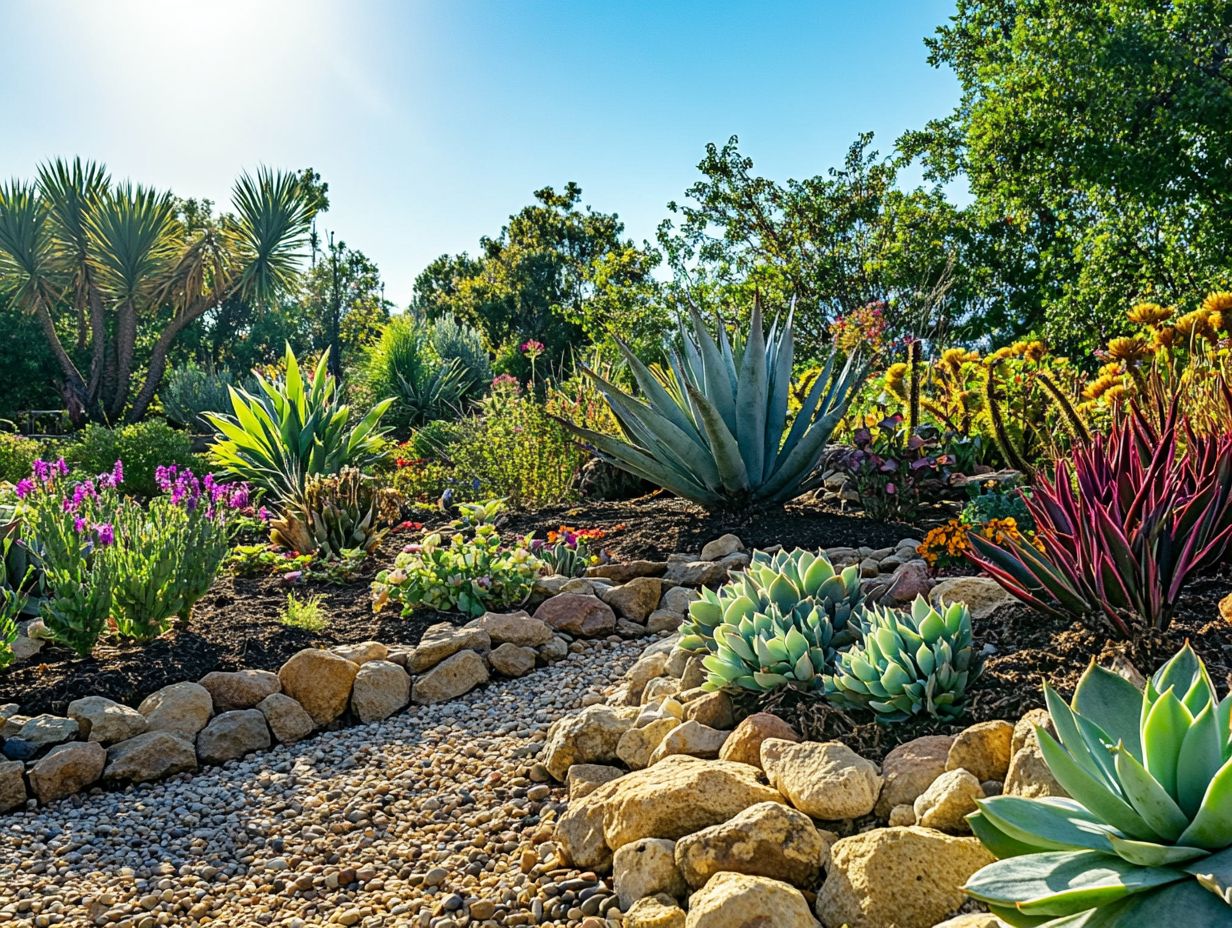
Choosing the right drought-resistant plants is crucial for crafting a sustainable garden that thrives in dry conditions. Start exploring the best drought-resistant plants now to transform your garden!
In California, opting for plants from the native palette boosts your garden’s resilience to drought and supports the local ecosystem. Integrating drought-tolerant trees, perennials, and ground covers creates a diverse landscape. This reduces the need for irrigation and upkeep.
Applying xeriscaping principles landscaping that minimizes water use helps optimize the arrangement and spacing of these plants. This ensures they reach their full growth potential while using water efficiently.
Types of Plants and Their Characteristics
Understanding the various types of plants and their characteristics is essential when you re on the hunt for drought-resistant options for your garden. Drought-resistant plants come in many forms think shrubs, perennials, and ground covers each with unique adaptations that allow them to flourish in dry conditions.
Take succulents, for instance, like agave and aloe. They’re famous for their water-storing leaves, making them a perfect fit for xeriscaping projects.
Then there are perennial flowers like coneflowers and black-eyed Susans; they not only endure dry spells but also attract pollinators, enriching the ecosystem of your drought-stricken garden. Ornamental grasses, such as blue fescue, contribute texture and visual appeal while benefiting from shallow root systems that efficiently capture rainfall.
By integrating these resilient varieties into your water-efficient irrigation practices or sustainable gardening designs, you can dramatically cut down on water usage and enhance the beauty of your arid outdoor spaces.
Creating a Drought-Resistant Garden
Building a drought-resistant garden is an exciting opportunity to get creative with your landscape! It requires thoughtful planning and design that emphasizes water conservation, resulting in a resilient and visually stunning landscape that demands less maintenance.
The cornerstone of this endeavor is effective landscape design, which integrates drought-tolerant species and native plants. This ensures optimal growth while significantly reducing water usage.
Utilizing efficient irrigation systems, such as drip irrigation, enhances water efficiency and delivers moisture directly to the plant roots where it s needed most.
Furthermore, employing techniques like mulching is essential for maintaining soil moisture, suppressing weeds, and enriching the soil. This ultimately fosters a thriving garden ecosystem.
Design Tips and Techniques
Designing a drought-resistant garden requires you to engage in strategic planning and implement specific techniques that optimize water use while enhancing the overall aesthetic. One effective approach is to create hydrozones, grouping plants with similar water needs. This allows you to tailor your irrigation systems to meet the specific requirements of each area.
Incorporating features like bioswales can also help manage rainwater runoff, supporting the natural hydrology of your landscape. Utilizing permeable paving for pathways enhances water infiltration, reduces erosion, and promotes healthier soil conditions, all while adding visual interest to your garden’s design.
Beyond these foundational strategies, implementing rain gardens is an excellent way to capture and naturally filter stormwater, allowing it to nourish the surrounding flora. Retention basins can play a crucial role by holding excess water during heavy rains, providing a habitat for wildlife, and thereby contributing to biodiversity.
Strategic plant placement further maximizes your garden’s efficiency. By arranging drought-tolerant species in the sunniest areas, you ensure they thrive with minimal irrigation. With these thoughtfully integrated design techniques, you can cultivate a landscape that not only withstands drought conditions but flourishes while promoting sustainable water practices.
Start your journey into the world of drought-resistant gardening today for a vibrant, sustainable space!
Maintaining a Drought-Resistant Garden
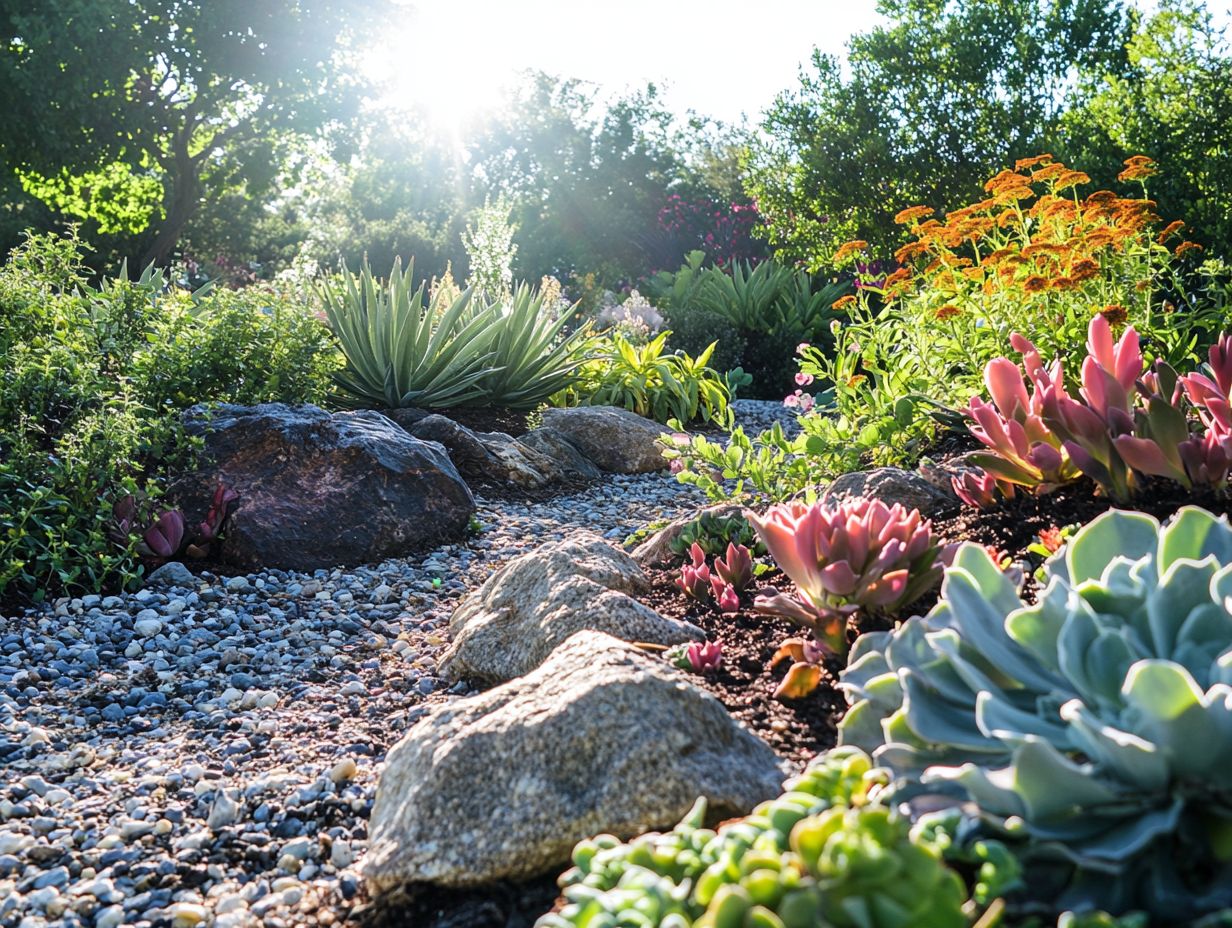
Maintaining a drought-resistant garden is essential for ensuring its longevity and resilience in arid conditions. You’ll need specific strategies tailored to the needs of drought-tolerant species.
Efficient watering techniques, such as deep watering and scheduling based on soil moisture levels, are pivotal for sustaining plant health while conserving water.
Regular plant maintenance, including adding mulch and compost, enhances soil quality and moisture retention. These practices preserve your landscape’s beauty and support environmental benefits.
Watering and Care Strategies
Implementing effective watering and care strategies is essential for the success of your drought-resistant garden, ensuring your plants receive the hydration they need without unnecessary waste.
Adopt techniques like mulching with organic materials to retain soil moisture while suppressing pesky weeds that compete for resources.
Choosing native and drought-tolerant species further enhances water efficiency, as these plants are naturally adapted to flourish in low-water conditions.
Understanding the specific needs of your different plants allows you to tailor your care routines. Organize group watering sessions for similar drought-resistant varieties.
Regularly assessing your garden s areas with different temperature and moisture levels will inform necessary adjustments in care, ensuring each plant receives optimal conditions for growth and resilience.
Ultimately, by integrating these strategies, you cultivate a thriving, eco-friendly garden that flourishes even during dry spells.
Cost Savings of Drought-Resistant Gardening
Imagine saving money every month while helping the planet! The economic benefits of drought-resistant gardening go far beyond just the initial investment in plants and landscaping.
You ll uncover ongoing financial benefits that can greatly impact both homeowners and commercial property owners.
By embracing water-saving strategies and choosing drought-tolerant species, you can significantly cut down on your water bills while also reducing landscape maintenance costs over time. Understanding the environmental benefits of drought gardening means you’re conserving resources, which only enhances their financial viability.
As environmental stewardship gains importance, investing in a drought-resistant garden not only saves you money but also contributes to the health benefits of gardening with drought plants for the entire community.
Calculating and Maximizing Savings
Calculating and maximizing your savings from drought-resistant gardening requires a thorough financial analysis. It’s also important to consider the environmental impact of drought-resistant gardening, along with elements like initial investment, ongoing maintenance costs, and potential reductions in your water bills.
You can track your water usage before and after implementing these drought-saving strategies, giving you a clearer picture of how your efforts translate into financial benefits.
By selecting the right mix of drought-tolerant species and efficient irrigation systems, which automatically water your plants, you can optimize your garden for both beauty and economic returns. This gives you the power to make informed decisions that contribute to long-term sustainability.
Along with these strategies, consider utilizing digital tools like smart irrigation controllers and water usage apps to elevate your financial tracking. These technologies offer real-time data on your water consumption, allowing you to analyze your bills in detail and spot trends along with areas for improvement.
Regularly auditing your maintenance costs such as landscaping services, soil amendments, and seasonal plant care will further arm you with valuable insights.
By keeping meticulous records and using spreadsheet software to categorize your expenses and savings, you can vividly visualize the financial impact of your choices. This visibility enables you to make adjustments that enhance both the sustainability and cost-effectiveness of your gardening efforts.
Frequently Asked Questions
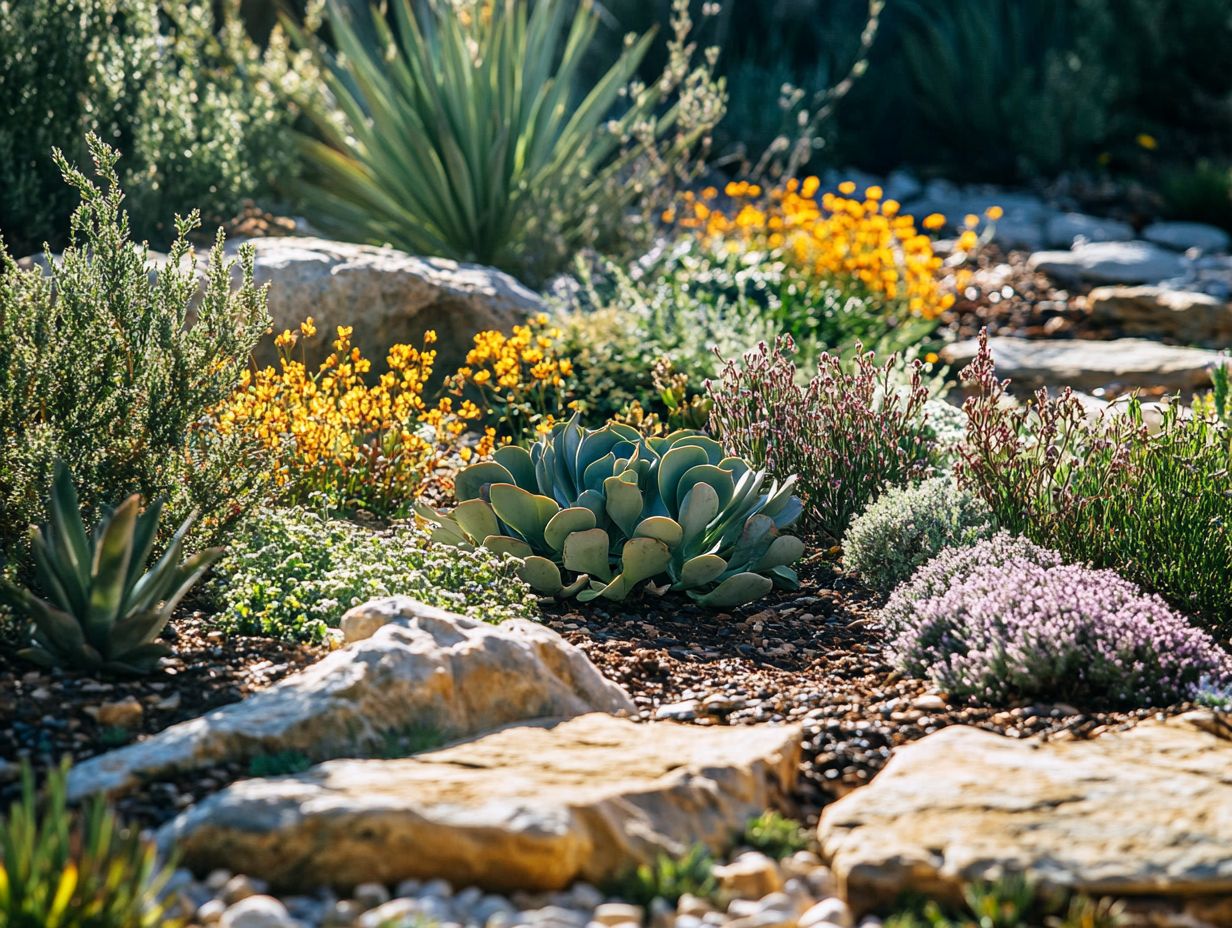
Have more questions about drought-resistant gardening? Let s dive in!
What is drought-resistant gardening and how can it save me money?
Drought-resistant gardening uses plants and methods that need less water, making it efficient and cost-effective in areas with limited water resources. Implementing water-saving gardening techniques for drought can further enhance your gardening efforts.
By cutting down on water usage, you can save money on your water bill and may not need expensive irrigation systems.
What are the key benefits of implementing drought-resistant gardening?
You also save water and reduce maintenance costs. Plus, using native plants promotes a healthier ecosystem.
What are some examples of drought-resistant plants?
Drought-resistant plants can survive with minimal watering and thrive in hot, dry conditions. Some examples include succulents, cacti, lavender, rosemary, and yucca.
Do I need to completely overhaul my current garden to make it drought-resistant?
No, you don t need to start from scratch. Simple changes like adding mulch, using a watering system that delivers water directly to the roots of plants, and choosing native plants can make a big difference.
Are there any financial incentives for implementing drought-resistant gardening?
In some areas, government or utility company programs offer rebates or incentives for adopting drought-resistant gardening practices. Don t miss out on potential savings check your local programs today!
Can I still have a beautiful garden with drought-resistant gardening?
Absolutely! Drought-resistant gardening doesn’t mean sacrificing beauty. You can transform your garden into an eye-catching oasis that dazzles with beautiful, colorful plants while conserving water and saving money.

